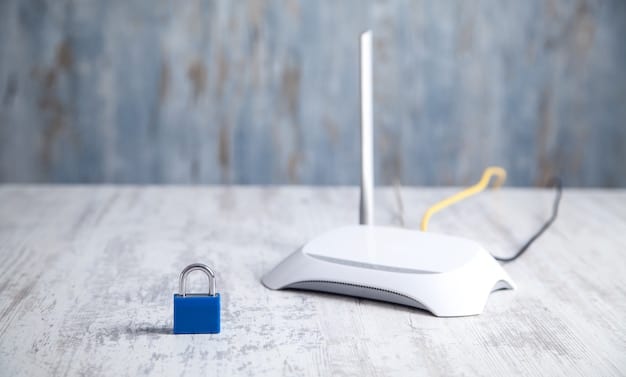Smart Home Data Security: Protect Your Home in 2025

Smart home data security in 2025 hinges on proactive measures like strong passwords, updated firmware, secure networks, and robust threat detection systems to protect against evolving cyber threats.
The proliferation of smart home devices has ushered in an era of unprecedented convenience, but it has also opened doors to new cybersecurity vulnerabilities. In 2025, securing your smart home is more critical than ever. This guide will explore smart home data security: how to protect your smart home from cyber threats in 2025, offering actionable steps and insights to safeguard your digital domain.
Understanding the Evolving Landscape of Smart Home Cyber Threats
The threat landscape surrounding smart home devices is constantly evolving. Cybercriminals are becoming more sophisticated, targeting vulnerabilities in IoT devices to gain access to personal data, control devices, or launch broader network attacks. Understanding these emerging threats is the first step in fortifying your smart home security.
Common Types of Cyber Threats Targeting Smart Homes
Several types of cyber threats specifically target smart home devices due to their inherent vulnerabilities and often lax security measures. Understanding these threats is crucial for implementing effective security strategies.
- Data breaches: Cybercriminals exploit vulnerabilities to steal sensitive data, such as login credentials, financial information, and personal details stored within smart devices or their associated cloud services.
- Device hijacking: Hackers gain unauthorized control over smart devices, potentially turning them into surveillance tools, launching DDoS attacks, or disrupting home automation systems.
- Malware infections: Smart devices can be infected with malware that compromises their functionality, steals data, or spreads to other devices on the network.
- Phishing attacks: Cybercriminals use deceptive emails or websites to trick users into revealing their smart home account credentials or installing malicious software.
Factors Contributing to Increased Vulnerabilities
Several factors contribute to the growing vulnerability of smart homes to cyber threats. Addressing these factors is essential for bolstering security.
- Weak default passwords: Many smart devices come with default passwords that are easily guessable, providing an easy entry point for hackers.
- Outdated firmware: Failure to update device firmware regularly leaves vulnerabilities unpatched, making them susceptible to exploitation.
- Lack of security awareness: Many users are unaware of the security risks associated with smart home devices and fail to implement basic security measures.
- Insecure networks: Weak Wi-Fi passwords and unsecure network configurations can provide unauthorized access to smart home devices.
By staying informed about the evolving threat landscape and understanding the factors contributing to vulnerabilities, homeowners can take proactive steps to mitigate risks and protect their smart homes from cyber threats.
Strengthening Your Home Network Security
Your home network is the backbone of your smart home, and securing it is paramount to protecting all connected devices. A robust network security setup acts as the first line of defense against cyber threats, preventing unauthorized access to your smart home ecosystem.

Implementing Strong Wi-Fi Security
Securing your Wi-Fi network is a critical first step in protecting your smart home. A strong Wi-Fi password and proper encryption protocols can prevent unauthorized access to your network and devices.
- Use a strong password: Choose a complex password that includes a mix of uppercase and lowercase letters, numbers, and symbols. Avoid using easily guessable information like birthdays or pet names.
- Enable WPA3 encryption: WPA3 is the latest Wi-Fi security protocol and offers stronger encryption than older protocols like WPA2. Ensure your router and devices support WPA3 and enable it in your router settings.
- Change the default SSID: Change the default name (SSID) of your Wi-Fi network to something unique and less easily identifiable.
Setting Up a Guest Network
Creating a separate guest network can further enhance your home network security. This allows you to provide internet access to guests without granting them access to your primary network and smart home devices.
- Isolate guest devices: A guest network isolates guest devices from your primary network, preventing them from accessing your sensitive data or smart home devices.
- Limit bandwidth usage: You can limit the bandwidth available to the guest network to prevent guests from hogging your internet connection.
- Change the password regularly: Changing the guest network password regularly adds an extra layer of security.
By implementing strong Wi-Fi security and setting up a guest network, you can significantly enhance the security of your home network and protect your smart home devices from unauthorized access.
Securing Individual Smart Devices
While network security is crucial, securing each individual smart device is equally important. Each device represents a potential entry point for cybercriminals, and neglecting individual device security can compromise your entire smart home ecosystem.
Changing Default Passwords Immediately
One of the most basic but crucial steps in securing smart devices is changing the default passwords immediately after installation. Default passwords are widely known and easily exploited by hackers.
- Unique passwords for each device: Use a unique, strong password for each smart device to prevent a compromise of one device from affecting others.
- Password managers: Consider using a password manager to generate and store complex passwords securely.
- Regular password updates: Change your smart device passwords regularly, especially if you suspect a security breach.
Keeping Firmware Updated
Smart device manufacturers regularly release firmware updates to patch security vulnerabilities and improve device performance. Keeping your device firmware updated is essential for maintaining a secure smart home.
- Enable automatic updates: If available, enable automatic firmware updates to ensure your devices are always running the latest security patches.
- Check for updates manually: If automatic updates are not available, check for firmware updates manually on a regular basis.
- Install updates promptly: Install firmware updates as soon as they are released to address any known security vulnerabilities.

By changing default passwords and keeping firmware updated, you can significantly reduce the risk of your smart devices being compromised by cyber threats.
Implementing Multi-Factor Authentication (MFA)
Multi-factor authentication (MFA) adds an extra layer of security to your smart home accounts by requiring you to provide multiple forms of verification when logging in. This makes it significantly more difficult for hackers to gain unauthorized access to your accounts, even if they have your password.
How MFA Works
MFA typically involves two or more of the following authentication factors:
- Something you know: This is your password.
- Something you have: This could be a code sent to your smartphone, a security key, or a biometric scan.
- Something you are: This could be a fingerprint scan or facial recognition.
By requiring multiple authentication factors, MFA makes it much harder for hackers to gain access to your accounts, even if they have stolen your password.
Enabling MFA on Smart Home Accounts
Many smart home device manufacturers and service providers offer MFA options for their accounts. Enabling MFA on these accounts can significantly enhance your smart home security.
- Check device settings: Check the settings of your smart home devices and apps to see if MFA is available.
- Enable MFA for all accounts: Enable MFA for all your smart home accounts that offer this feature.
- Use a strong authentication method: Choose a strong authentication method, such as a security key or authenticator app, rather than relying solely on SMS codes, which are vulnerable to interception.
Implementing MFA is a simple but highly effective way to protect your smart home accounts from unauthorized access.
Utilizing Virtual Private Networks (VPNs)
A Virtual Private Network (VPN) creates a secure, encrypted connection between your devices and the internet. This can protect your data from eavesdropping and prevent hackers from intercepting your personal information as it travels over the network.
How VPNs Enhance Smart Home Security
VPNs enhance smart home security by:
- Encrypting data: VPNs encrypt all data transmitted between your devices and the internet, making it unreadable to eavesdroppers.
- Hiding your IP address: VPNs mask your IP address, making it more difficult for hackers to track your online activity and identify your location.
- Protecting against public Wi-Fi risks: VPNs protect your data when using public Wi-Fi networks, which are often insecure and vulnerable to hacking.
Choosing a Reliable VPN Service
When choosing a VPN service, consider the following factors:
- Security features: Look for a VPN service that offers strong encryption, a no-logs policy, and a kill switch feature.
- Server locations: Choose a VPN service with servers located in multiple countries to bypass geo-restrictions and access content from around the world.
- Speed and reliability: Opt for a VPN service that offers fast connection speeds and reliable performance.
- Privacy policy: Review the VPN service’s privacy policy carefully to ensure they do not collect or share your personal data.
By utilizing a VPN, you can add an extra layer of security to your smart home and protect your data from cyber threats.
Regular Security Audits and Risk Assessments
Regular security audits and risk assessments are crucial for identifying vulnerabilities and weaknesses in your smart home security posture. By conducting these assessments, you can proactively address potential risks and strengthen your defenses against cyber threats.
Conducting a Self-Assessment
You can conduct a self-assessment of your smart home security by:
- Reviewing device settings: Regularly review the settings of your smart home devices to ensure they are configured securely.
- Checking for vulnerabilities: Use online tools to scan your network for vulnerabilities.
- Monitoring network activity: Monitor your network activity for suspicious behavior.
Seeking Professional Assistance
For a more comprehensive assessment, consider seeking professional assistance from a cybersecurity expert. A professional can conduct a thorough audit of your smart home security and identify vulnerabilities that you may have missed.
By performing regular security audits and risk assessments, you can stay ahead of potential threats and ensure your smart home remains secure.
| Key Point | Brief Description |
|---|---|
| 🔑 Strong Passwords | Use complex, unique passwords for each device and account. |
| 🛡️ Updated Firmware | Keep device firmware updated to patch security vulnerabilities. |
| 📶 Secure Network | Implement strong Wi-Fi security and set up a guest network. |
| 🔒 MFA | Enable Multi-Factor Authentication for added security. |
FAQ
▼
In 2025, major risks include data breaches, device hijacking, malware infections, and phishing attacks. These threats target vulnerabilities in devices with weak security practices.
▼
Use a combination of uppercase and lowercase letters, numbers, and symbols. Avoid personal information and use a different, unique password for each device.
▼
Firmware updates patch security vulnerabilities that hackers can exploit. Keeping your firmware current ensures you have the latest security enhancements and protections.
▼
MFA requires multiple verification methods to log in, such as a password and a code from your phone. It adds an extra layer of security, preventing unauthorized access.
▼
A VPN encrypts your internet connection, hiding your IP address and protecting your data from eavesdropping, especially on public Wi-Fi networks. Look for services prioritizing security.
Conclusion
Securing your smart home in 2025 requires a proactive and multi-layered approach. By implementing the strategies outlined in this guide – from strengthening your network security to securing individual devices and embracing advanced security measures like MFA and VPNs – you can significantly reduce your risk and enjoy the convenience of your smart home with greater peace of mind.





